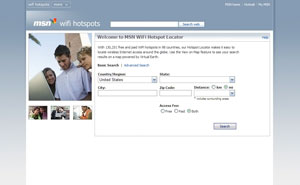
Wi-Fi is a family of wireless network protocols based on the IEEE 802.11 family of standards, which are commonly used for local area networking of devices and Internet access, allowing nearby digital devices to exchange data by radio waves. These are the most widely used computer networks in the world, used globally in home and small office networks to link devices together and to a wireless router to connect them to the Internet, and in wireless access points in public places like coffee shops, hotels, libraries, and airports to provide visitors with Internet connectivity for their mobile devices.

Wardriving is the act of searching for Wi-Fi wireless networks, usually from a moving vehicle, using a laptop or smartphone. Software for wardriving is freely available on the internet.

MobileStar Network was a wireless Internet service provider which first gained notability in deploying Wi-Fi Internet access points in Starbucks coffee shops, American Airlines Admiral Club locations across the United States and at Hilton Hotels. Founded by Mark Goode and Greg Jackson in 1998, MobileStar was the first wireless ISP to place a WiFi hotspot in an airport, a hotel, or a coffee shop. MobileStar's core value proposition was to provide wireless broadband connectivity for the business traveler in all the places s/he was likely to "sleep, eat, move, or meet." MobileStar's founder, Mark Goode, was the first to coin the now industry standard expression "hotspot," as a reference to a location equipped with an 802.11 wireless access point.

A hotspot is a physical location where people can obtain Internet access, typically using Wi-Fi technology, via a wireless local-area network (WLAN) using a router connected to an Internet service provider.

Voice over Wireless LAN (VoWLAN), also Voice over WiFi (VoWiFi), is the use of a wireless broadband network according to the IEEE 802.11 standards for the purpose of vocal conversation. In essence, it is Voice over IP (VoIP) over a Wi-Fi network. In most cases, the Wi-Fi network and voice components supporting the voice system are privately owned.

RailTel Corporation of India Ltd. is an Indian public sector enterprise which provides broadband and VPN services. RailTel was formed in September 2000 with the objective of creating a nationwide broadband, telecom and multimedia network, and to modernise train control operation and safety system of Indian Railways. RailTel's network passes through around 5,000 stations across the country, covering all major commercial centres.

Wireless security is the prevention of unauthorized access or damage to computers or data using wireless networks, which include Wi-Fi networks. The term may also refer to the protection of the wireless network itself from adversaries seeking to damage the confidentiality, integrity, or availability of the network. The most common type is Wi-Fi security, which includes Wired Equivalent Privacy (WEP) and Wi-Fi Protected Access (WPA). WEP is an old IEEE 802.11 standard from 1997. It is a notoriously weak security standard: the password it uses can often be cracked in a few minutes with a basic laptop computer and widely available software tools. WEP was superseded in 2003 by WPA, a quick alternative at the time to improve security over WEP. The current standard is WPA2; some hardware cannot support WPA2 without firmware upgrade or replacement. WPA2 uses an encryption device that encrypts the network with a 256-bit key; the longer key length improves security over WEP. Enterprises often enforce security using a certificate-based system to authenticate the connecting device, following the standard 802.11X.

A municipal wireless network is a citywide wireless network. This usually works by providing municipal broadband via Wi-Fi to large parts or all of a municipal area by deploying a wireless mesh network. The typical deployment design uses hundreds of wireless access points deployed outdoors, often on poles. The operator of the network acts as a wireless internet service provider.

A home network or home area network (HAN) is a type of computer network that facilitates communication among devices within the close vicinity of a home. Devices capable of participating in this network, for example, smart devices such as network printers and handheld mobile computers, often gain enhanced emergent capabilities through their ability to interact. These additional capabilities can be used to increase the quality of life inside the home in a variety of ways, such as automation of repetitive tasks, increased personal productivity, enhanced home security, and easier access to entertainment.
TTNET A.Ş., operating under the Türk Telekom brand, is the largest Internet service provider in Turkey and has around 7 million subscribers. TTNET is a subsidiary of Türk Telekom Group.
Generic Access Network (GAN) is a protocol that extends mobile voice, data and multimedia applications over IP networks. Unlicensed Mobile Access (UMA) is the commercial name used by mobile carriers for external IP access into their core networks. The latest generation system is named Wi-Fi calling or VoWiFi by a number of handset manufacturers, including Apple and Samsung, a move that is being mirrored by carriers like T-Mobile US and Vodafone. The service is dependent on IMS, IPsec, IWLAN and ePDG.

MSN WiFi Hotspots, previously Windows Live WiFi Hotspot Locator, was a website that helped users to locate wireless Internet hotspots worldwide and view their positions on a map using Live Search Maps.
Piggybacking on Internet access is the practice of establishing a wireless Internet connection by using another subscriber's wireless Internet access service without the subscriber's explicit permission or knowledge. It is a legally and ethically controversial practice, with laws that vary by jurisdiction around the world. While completely outlawed or regulated in some places, it is permitted in others.

Wireless@SG is a wireless broadband programme developed by the Infocomm Development Authority (IDA) of Singapore as part of its Next Generation National Infocomm Infrastructure initiative, being part of the nation's 10-year masterplan called Intelligent Nation 2015 (iN2015).
Wi-Fi Direct is a Wi-Fi standard for peer-to-peer wireless connections that allows two devices to establish a direct Wi-Fi connection without an intermediary wireless access point, router, or Internet connection. Wi-Fi Direct is single-hop communication, rather than multi-hop communication like wireless ad hoc networks.
Mobile data offloading is the use of complementary network technologies for delivering data originally targeted for cellular networks. Offloading reduces the amount of data being carried on the cellular bands, freeing bandwidth for other users. It is also used in situations where local cell reception may be poor, allowing the user to connect via wired services with better connectivity.
Connectify is an American software company that develops networking software for consumers, professionals and companies. Connectify Hotspot is a virtual router software for Microsoft Windows, and Speedify is a mobile VPN service with channel bonding capabilities available for individuals, families and teams.
Opensignal is an independent analytics company specialising in "quantifying the mobile-network experience".
Mozilla Location Service (MLS) is an open geolocation service which allows devices to find their position by processing their received signals of publicly observable radio transmitters: cellular network antennae, Wi-Fi access points, and Bluetooth beacons. The service is provided by Mozilla since 2013. The service uses Mozilla's open source software project called Ichnaea.
Chrome Fi Wireless, formerly Project Fi and Google Fi, is an MVNO telecommunications service by Google that provides telephone calls, SMS, and mobile broadband using cellular networks and Wi-Fi. Google Fi uses the T-Mobile network. Google Fi is a service for US residents only, as of late 2019.









